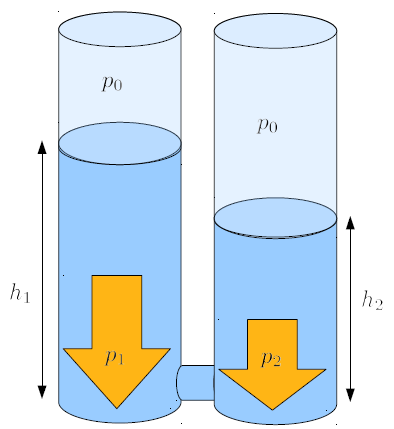Pressure difference
Storyboard 
When two columns of liquid with different heights are connected, it can generate a pressure difference that leads to a flow of liquid from the taller column to the shorter one. This movement continues until both columns reach the same height, eliminating any pressure difference.
ID:(1608, 0)
Pressure difference
Storyboard 
When two columns of liquid with different heights are connected, it can generate a pressure difference that leads to a flow of liquid from the taller column to the shorter one. This movement continues until both columns reach the same height, eliminating any pressure difference.
Variables
Calculations
Calculations
Equations
As the the column force ($F$) generated by a column of liquid of the column height ($h$), the column Section ($S$), the liquid density ($\rho_w$), and the gravitational Acceleration ($g$) is
and the the water column pressure ($p$) is then defined as
we have that the the water column pressure ($p$) generated by a column of liquid is
As the the column force ($F$) generated by a column of liquid of the column height ($h$), the column Section ($S$), the liquid density ($\rho_w$), and the gravitational Acceleration ($g$) is
and the the water column pressure ($p$) is then defined as
we have that the the water column pressure ($p$) generated by a column of liquid is
If there is the pressure difference ($\Delta p$) between two points, as determined by the equation:
we can utilize the water column pressure ($p$), which is defined as:
This results in:
$\Delta p=p_2-p_1=p_0+\rho_wh_2g-p_0-\rho_wh_1g=\rho_w(h_2-h_1)g$
As the height difference ($\Delta h$) is:
the pressure difference ($\Delta p$) can be expressed as:
Examples
If two columns of water with different heights at their bases are connected, a situation arises where there is a pressure difference along the connecting tube.
This setup allows us to study how the pressure difference generates a liquid flow along the tube. We can consider an element of liquid with a certain length and a section equal to that of the tube, and estimate the corresponding mass using the density. With the section, we can also convert the pressure difference into a force difference and, ultimately, study how volumes in liquids are accelerated due to pressure differences.
If there is the pressure difference ($\Delta p$) between two points, as determined by the equation:
we can utilize the water column pressure ($p$), which is defined as:
This results in:
$\Delta p=p_2-p_1=p_0+\rho_wh_2g-p_0-\rho_wh_1g=\rho_w(h_2-h_1)g$
As the height difference ($\Delta h$) is:
the pressure difference ($\Delta p$) can be expressed as:
When two liquid columns are connected with the height of liquid column 1 ($h_1$) and the height of liquid column 2 ($h_2$), a the height difference ($\Delta h$) is formed, which is calculated as follows:
the height difference ($\Delta h$) will generate the pressure difference that will cause the liquid to flow from the higher column to the lower one.
When two liquid columns are connected with the pressure in column 1 ($p_1$) and the pressure in column 2 ($p_2$), a the pressure difference ($\Delta p$) is formed, which is calculated according to the following formula:
the pressure difference ($\Delta p$) represents the pressure difference that will cause the liquid to flow from the taller column to the shorter one.
If we consider the expression of the column force ($F$) and divide it by the column Section ($S$), we obtain the water column pressure ($p$). In this process, we simplify the column Section ($S$), so it no longer depends on it. The resulting expression is:
If we consider the expression of the column force ($F$) and divide it by the column Section ($S$), we obtain the water column pressure ($p$). In this process, we simplify the column Section ($S$), so it no longer depends on it. The resulting expression is:
The height difference, denoted by the height difference ($\Delta h$), implies that the pressure in both columns is distinct. In particular, the pressure difference ($\Delta p$) is a function of the liquid density ($\rho_w$), the gravitational Acceleration ($g$), and the height difference ($\Delta h$), as follows:
ID:(1608, 0)

